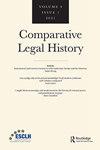爱、公义和律法:基督徒的爱如何塑造律法?
IF 0.5
Q2 LAW
引用次数: 0
摘要
执行契约和状态关系。《法律的艺术》给读者带来启发,但也(也许是有意地)让读者想要更多的方向和分析。一直存在的问题是展出了什么。作为21世纪的观众,我们看到的是由一个权威的法律机构做出的决定,还是这些艺术品是艺术选择和(如某些章节所暗示的)奇思妙想?我们如何理解不同的观众把什么当作我们现在看到的物体的信息呢?此外,我们生活在一个充斥着图像的世界里,如何才能瞥见(一个精心挑选的词)这些图像在展出时对观看者的影响。例如,当法官被分配到写有“你们被审判,就像你们被审判”的房间时,他们应该采取什么指示?总而言之,本卷的读者将学到很多关于与法律相关的图像学的历史,但较少关于跨地方的政治和社会力量,使“正义”清晰,建立令人印象深刻的结构,并将某些叙述压入公众意识。此外,一些(但不是全部)作者提出了一个挥之不去的问题:考虑到社会运动已经将裁决转变为民主国家的一种实践,并且在许多国家,法院不仅成为裁决的象征,而且更普遍地成为政府的象征,如何看待这些意象的持续可读性?本文章由计算机程序翻译,如有差异,请以英文原文为准。
Agape, justice, and law: how might Christian love shape law?
enforce contracts and status relationships. The Art of Law edifies but also (and perhaps intentionally) leaves readers wanting more direction and analyses. The ever-present question is about what was put on view. Are we, twenty-first-century viewers, looking at decisions dictated by a governing legal body, or are these artefacts of artistic choice and (as some chapters suggest) whimsy? How are we to understand what the different spectators took to be the messages of the objects we look at now? Furthermore, how do we, living in a world awash with images, glimpse (a word chosen advisedly) the impact on those who looked at the images when put on display. What were the directives judges were supposed to take, for example, when assigned to rooms inscribed with the words ‘Judge ye, as ye shall be judged’? In sum, readers of this volume will learn a great deal about the history of iconography associated with law but less about the translocal political and social forces that render ‘Justice’ legible, that built impressive structures, and that pressed certain narratives into public consciousness. Furthermore, the haunting question addressed by some, but not all, of the authors remains: how to think about the continued legibility of much of this imagery, given that social movements have transformed adjudication into a practice embedded in democracies and, in many countries, have produced courthouses as an icon not only of adjudication but also of government more generally?
求助全文
通过发布文献求助,成功后即可免费获取论文全文。
去求助
来源期刊
CiteScore
1.70
自引率
0.00%
发文量
20
期刊介绍:
Comparative Legal History is an international and comparative review of law and history. Articles will explore both ''internal'' legal history (doctrinal and disciplinary developments in the law) and ''external'' legal history (legal ideas and institutions in wider contexts). Rooted in the complexity of the various Western legal traditions worldwide, the journal will also investigate other laws and customs from around the globe. Comparisons may be either temporal or geographical and both legal and other law-like normative traditions will be considered. Scholarship on comparative and trans-national historiography, including trans-disciplinary approaches, is particularly welcome.

 求助内容:
求助内容: 应助结果提醒方式:
应助结果提醒方式:


